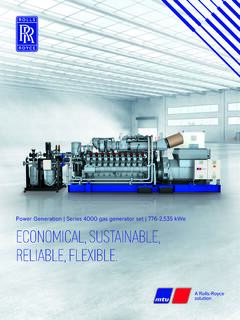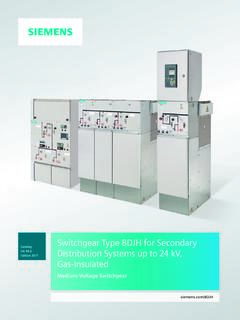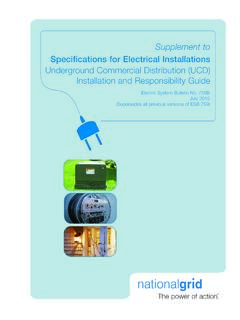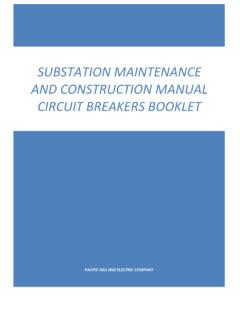Transcription of Electrical switchgear safety: A guide for owners and users
1 Page 1 of 9 Health and Safety ExecutiveElectrical switchgear safety A guide for owners and users This is a web-friendly version of leaflet INDG372(rev1), published 04/13 IntroductionThis guidance is for owners and operators of Electrical switchgear in industrial and commercial organisations with little Electrical knowledge or expertise available in-house. It provides a summary of HSG230 Keeping Electrical switchgear safe, which provides detailed advice for organisations employing Electrical engineering managers and specialists (see Further reading ). The guidance will help you to keep your Electrical switchgear safe by covering selection, use, care and maintenance. It will also help you to manage: three-phase Electrical switchgear with voltage ratings from 1000 33 000 volts alternating current (ac); circuit-breakers, switches, switch fuses, isolators and contactors operating at voltages above 1000 volts ac.
2 It does not cover direct current (dc) switchgear , low-voltage switchgear (voltages up to 1000 volts ac) and switchgear used on single-phase ac traction systems. Although switchgear is generally reliable and performs well, failures, though rare, may be catastrophic. Rupturing of oil-filled switchgear tanks will usually result in burning oil and gas clouds, which can cause death or serious injury and major damage to nearby plant and buildings. Failures of switchgear can also result in serious financial losses. Using switchgear that contains sulphur hexafluoride gas and/or a vacuum removes the hazard of burning oil but introduces other risks that need to be managed. Experience of previous accidents has shown that failure usually occurs at, or shortly after, operation of the equipment. The continuing integrity of the safe operation of switchgear can depend on: how it is operated; its condition; external factors, such as the circumstances existing in the Electrical network at the time of operation.
3 Managing switchgearAs part of managing the health and safety of your business, you must control the risks in your workplace. If you use switchgear you must assess the risks and manage them to ensure safe operation and minimise the risk of injury. A risk assessment is about identifying and taking sensible and proportionate measures to control the risks in your workplace, not about creating huge amounts of paperwork. You are probably already taking steps to protect your employees, but your risk assessment will help you decide whether you should be doing and Safety ExecutiveElectrical switchgear safety: A guide for owners and users Page 2 of 9 The following might help: Think about how the switchgear could injure or harm the health of your employees and others. Ask your employees what they think the hazards are, as they may notice things that are not obvious to you and may have some good ideas on how to control the risks.
4 Check manufacturers instructions or safety data sheets for chemicals and equipment, as they can be very helpful in spelling out the hazards. Some workers may have particular requirements; for example, new and young workers, migrant workers, people with disabilities, temporary workers, contractors and lone workers may be at particular risk. Having identified the hazards, you then have to decide what you need to do to manage them responsibly. Generally, you need to do everything reasonably practicable to protect people from harm. An explanation to what reasonably practicable means is provided at Your strategy for managing the risk should include: system information and record-keeping; policies and procedures covering the installation, commissioning, operation, maintenance and removal of the equipment; allocation of defined roles and responsibilities; supervision and training requirements for your people.
5 Make a record of the significant findings from your risk assessment and what you have in place to control the risks. Any record produced should be simple and focused on controls. If you have fewer than five employees, you do not have to write anything down. But it is useful to do this so you can review it at a later date; for example, if something changes. If you have five or more employees, you are required by law to write it auditing regime, although not required by law, may help you to monitor and maintain the effectiveness of the procedures. You are responsible for managing the risks of your business. Many businesses develop the necessary expertise in-house and are well equipped to carry out an assessment and decide on the appropriate actions. If there are things you are not able to do, you may need external help from suitably competent persons or organisations to help you comply with the law, eg: electricity distribution companies; switchgear manufacturers; switchgear maintenance companies with particular expertise in your type of switchgear ; consulting organisations specialising in switchgear ; technical services companies.
6 These people may also be able to provide training for competent and author-ised persons (see HSG230 in Further reading for further information on these terms). You should consider employing someone in-house who is competent to deal with emergencies. Health and Safety ExecutiveElectrical switchgear safety: A guide for owners and users Page 3 of 9 System information While not a legal requirement, you should keep a record of your Electrical installation system information; this can help you keep your equipment safe. If you do decide to keep such information it is prudent to include: diagram(s) of the Electrical network showing the interconnections between the various plant items, including the switchgear and their location(s) and fault levels at all relevant points; types of equipment as part of an asset register, including details such as manufacturer, model, serial number, year of manufacture, date of installation, voltage current and short-circuit rating and details of the operating mechanism; details of operational limitations due, for example, to the possibility of overstressing (ie if operated under fault conditions it is unable to cope with the resulting Electrical and thermal stress that can sometimes lead to catastrophic failure); a maintenance record of each item of switchgear .
7 The number of fault clearance operations since circuit-breakers were last maintained (if known); details of any modifications carried out; for example, whether there are arc control devices for oil-filled circuit-breakers or the fitting of anti-reflex control handles (these operate one-way, imposing a time delay when they are removed and refitted before carrying out a further operation). If this information is not available, you will need to verify that your equipment complies with the law or, as a matter of urgency, take the actions necessary to make sure that it will do will be a low-voltage installation associated with the switchgear and the basic records for this may also contain Electrical installation certificates and periodic inspection reports. For more information see BS 7671 Requirements for Electrical installations in Further reading.
8 Policies and procedures Safety of the equipment: Assessing the risks You should assess the switchgear and the Electrical network to identify any potential risks and problems; the system information can help you do this. Risks and problems can include: lack of maintenance; overstressing of switchgear ; presence of equipment having dependent manual operation, ie where the movement of the switchgear contacts is directly dependent on the movement of the operating handle by the operator; absence of anti-reflex control handles; inadequate means of protection against fire; limited access and egress. From this assessment you will be able to identify the action(s) you must take to make sure that the equipment and systems are being operated safely, which may include: prohibiting operation of overstressed switchgear when live, including disabling automatic operation to clear faults on the system.
9 This will involve adjustments to Electrical protection upstream to ensure the system remains protected; Health and Safety ExecutiveElectrical switchgear safety: A guide for owners and users Page 4 of 9 preventing access to the switchgear when live; reducing fault levels, wherever possible, by reconfiguring the network; prohibiting the operation of dependent manually-operated switchgear when live, except under very carefully controlled conditions; replacing overstressed switchgear . Further actions you may need to take (the urgency of which will depend on the results of your assessment) could include: replacing overstressed switchgear ; when possible, replacing the closing mechanism for dependent manually-operated switchgear . When this is not possible, you must replace the switchgear ; fitting anti-reflex handles; improving measures for protection against fire.
10 Once you have decided on the actions you will take, you must make a plan to carry them out. Operating procedures You should develop operating procedures and select the appropriately trained people (see Roles and responsibilities ) for the activities needed to operate, inspect, repair, maintain and test the switchgear . Those carrying out any of the activities must: have the appropriate knowledge of the safety rules; know how to apply the safety documents; know their responsibilities to ensure safety and for safe working. Their level of knowledge of the switchgear could range from a general understanding to detailed technical knowledge depending on the duties you give them. For more information see HSG85 Electricity at work. Safe working practices in Further reading .Safety rules and safety documents You should develop and implement safety rules and a safety documents scheme (for example, use of limitation-of-access and permit-to-work forms) as they are key to safety in the use, care and maintenance of plant.

















